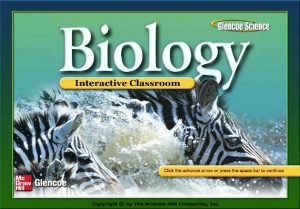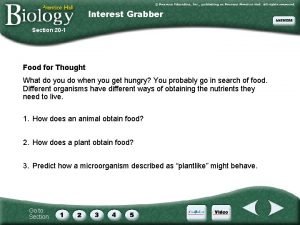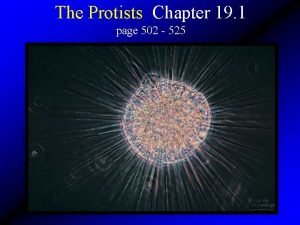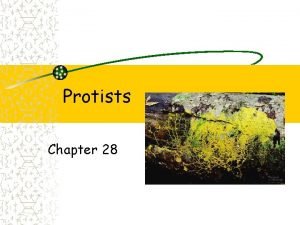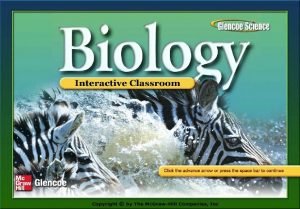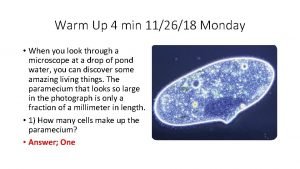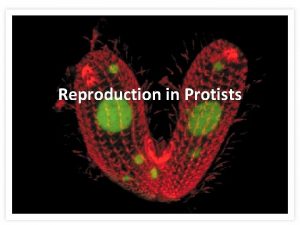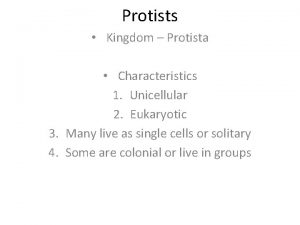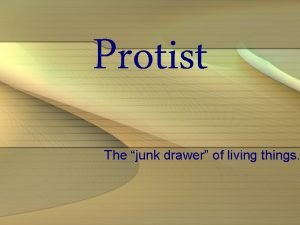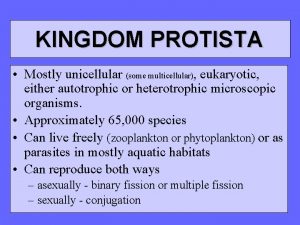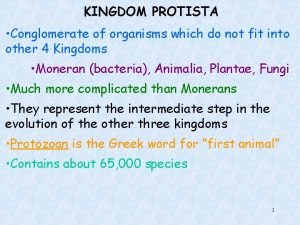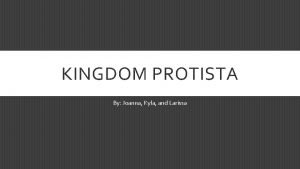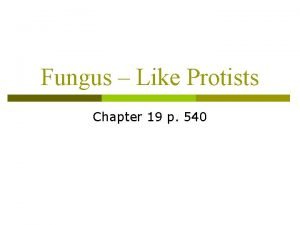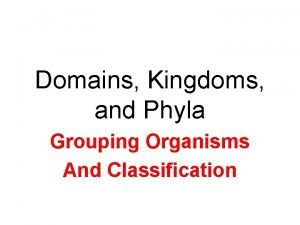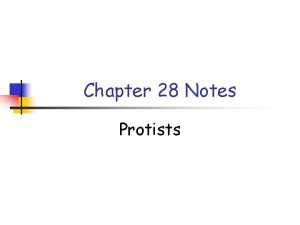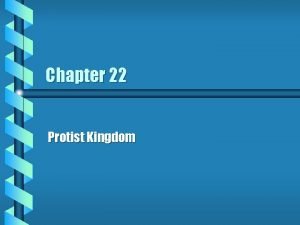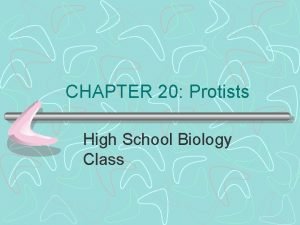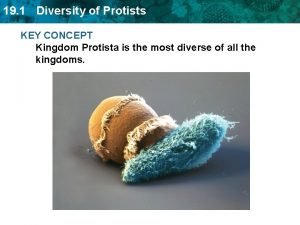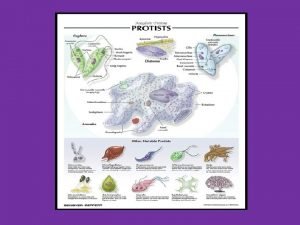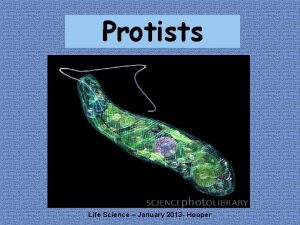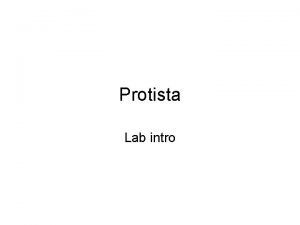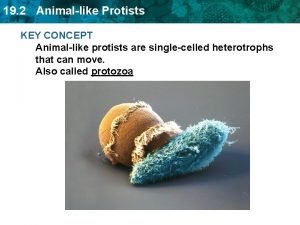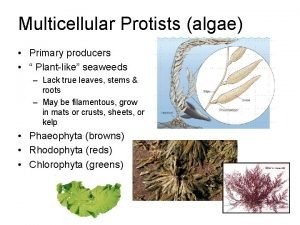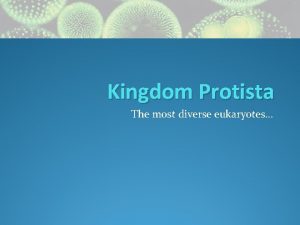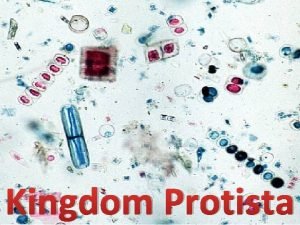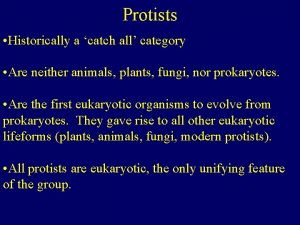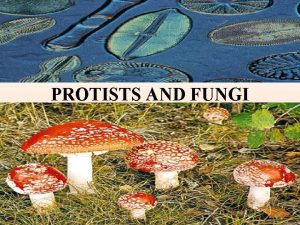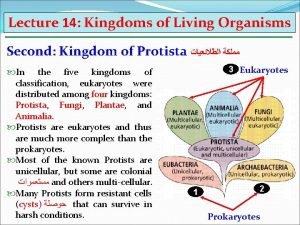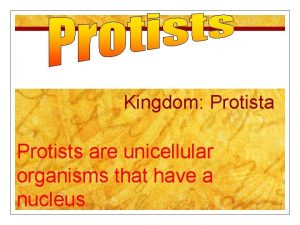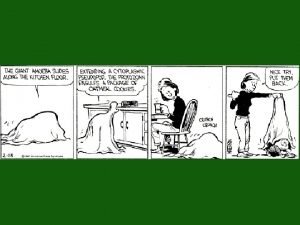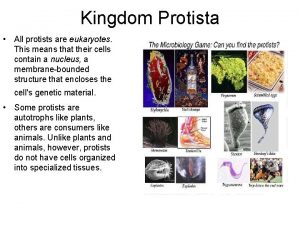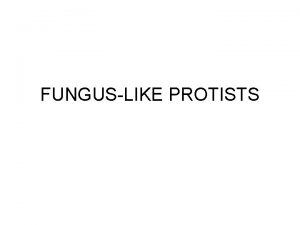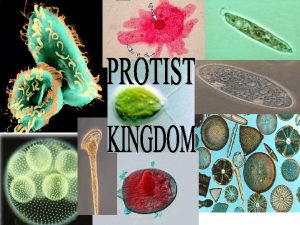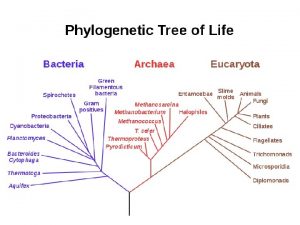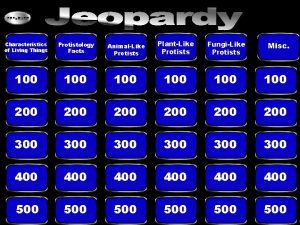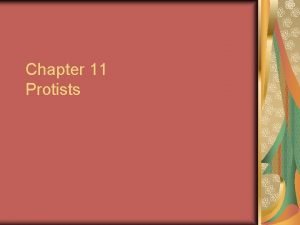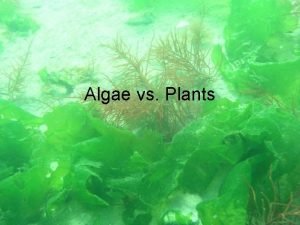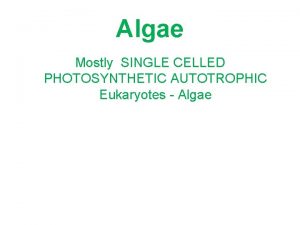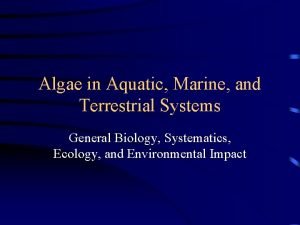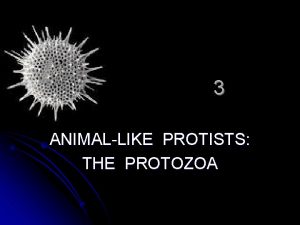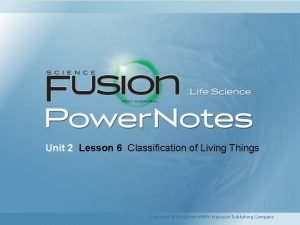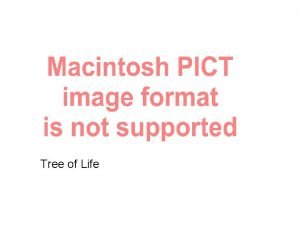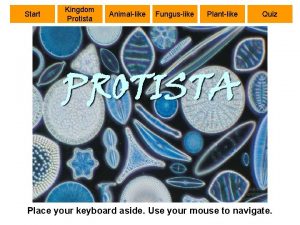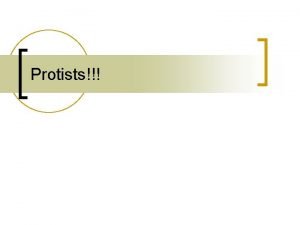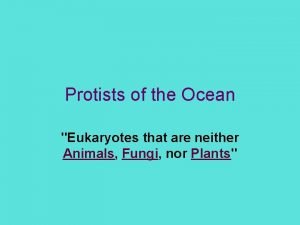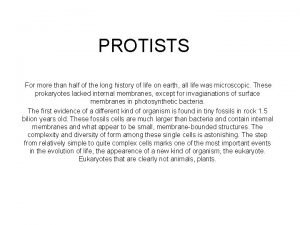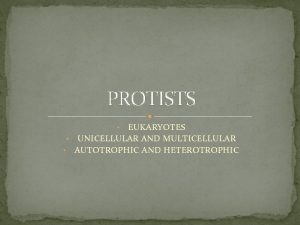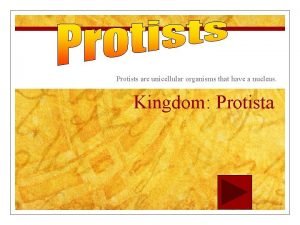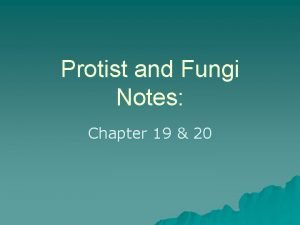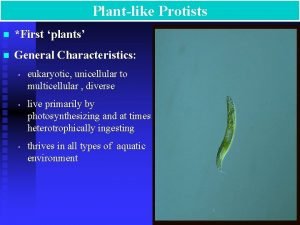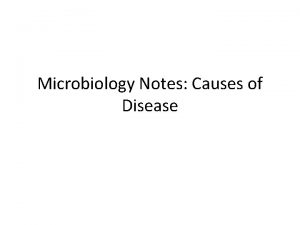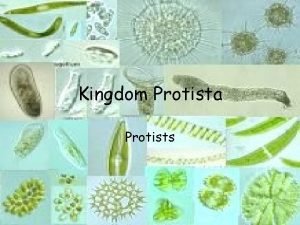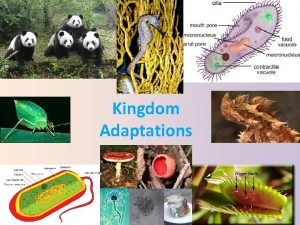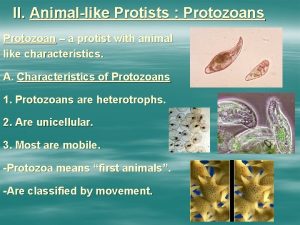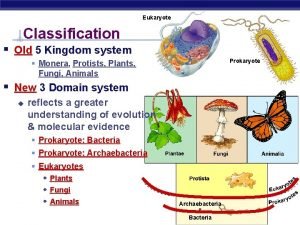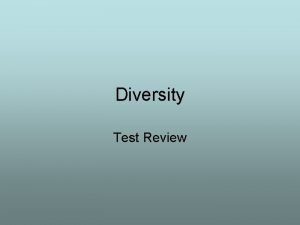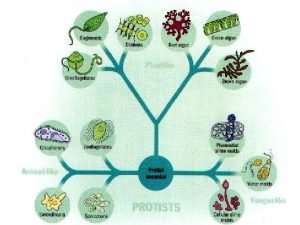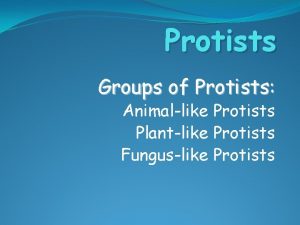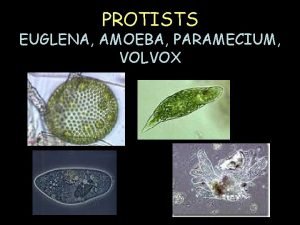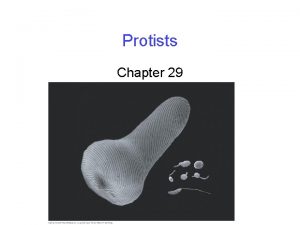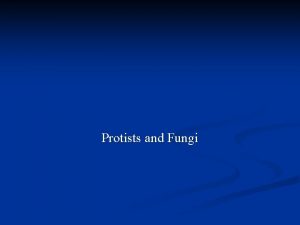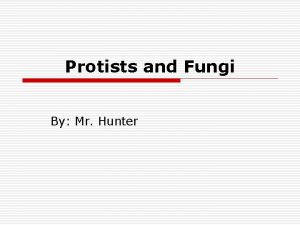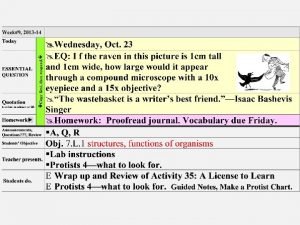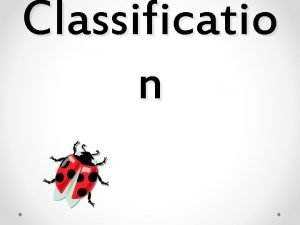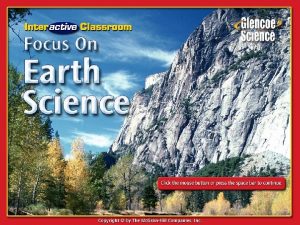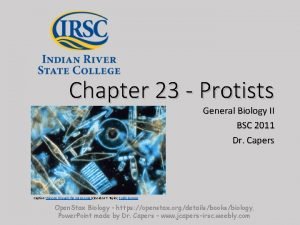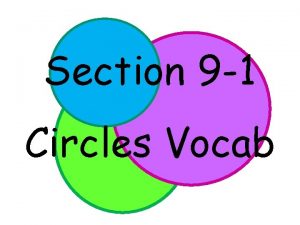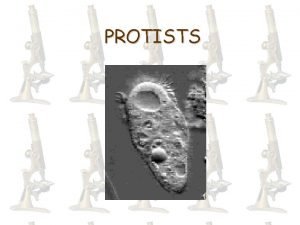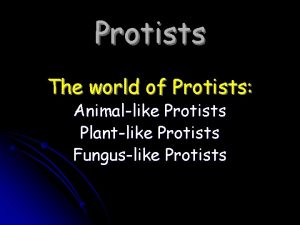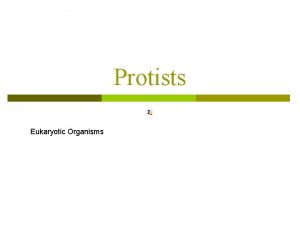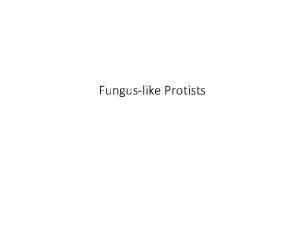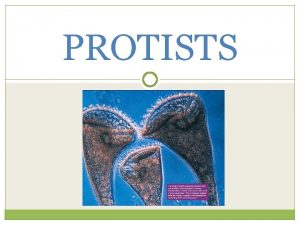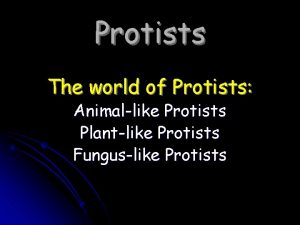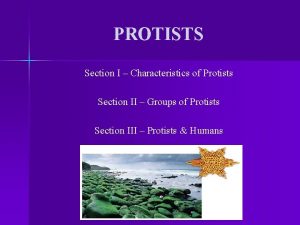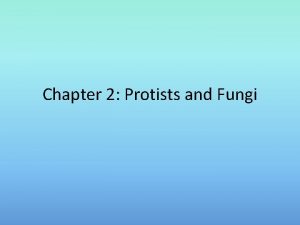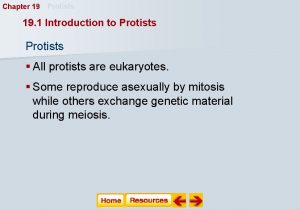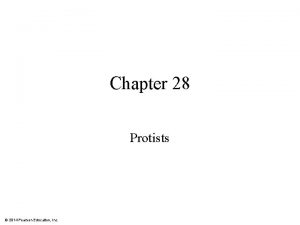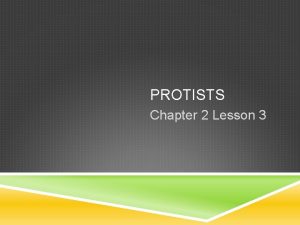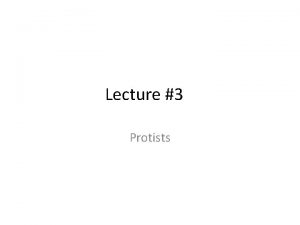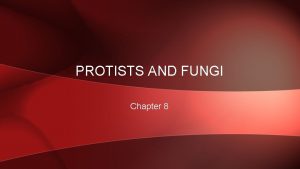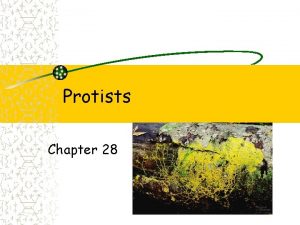Chapter 19 Protists Section 1 Introduction to Protists




















































































- Slides: 84


Chapter 19 Protists Section 1: Introduction to Protists Section 2: Protozoans—Animal-like Protists Section 3: Algae—Plantlike Protists Section 4: Funguslike Protists Click on a lesson name to select.

Chapter 19 Protists 19. 1 Introduction to Protists § All protists are eukaryotes. § Some reproduce asexually by mitosis while others exchange genetic material during meiosis.

Chapter 19 Protists 19. 1 Introduction to Protists Classifying Protists § Some scientists classify protists by their methods of obtaining nutrition. § Animal-like protists § Plantlike protists § Funguslike protists

Chapter 19 Protists 19. 1 Introduction to Protists Animal-like Protists § Protozoans are heterotrophs and usually ingest bacteria, algae, or other protozoans.

Chapter 19 Protists 19. 1 Introduction to Protists Plantlike Protists § Plantlike protists make their own food through photosynthesis. § Algae

Chapter 19 Protists 19. 1 Introduction to Protists Funguslike Protists § Funguslike protists absorb their nutrients from other organisms.

Chapter 19 Protists

Chapter 19 Protists 19. 2 Protozoans—Animal-like Protists Ciliophora § Biologists further classify protozoans by their method of movement. § Members of the phylum Ciliophora are animallike protists that have numerous short, hairlike projections. § There are over 7000 species of ciliates.

Chapter 19 Protists 19. 2 Protozoans—Animal-like Protists Paramecia Magnification unavailable § A unicellular protozoan § Enclosed by a layer of membrane called a pellicle. Paramecia

Chapter 19 Protists 19. 2 Protozoans—Animal-like Protists Cilia § Cilia on the paramecium are used for moving and feeding. Contractile Vacuoles § The contractile vacuoles collect the excess water from the cytoplasm and expel it from the cell.

Chapter 19 Protists 19. 2 Protozoans—Animal-like Protists Visualizing Paramecia

Chapter 19 Protists 19. 2 Protozoans—Animal-like Protists Sarcodina § Animal-like protists that use pseudopods for feeding and locomotion § The most commonly studied sarcodines are found in the genus Amoeba.

Chapter 19 Protists 19. 2 Protozoans—Animal-like Protists § Chemical stimuli from smaller organisms can cause the amoeba to form pseudopods from their plasma membrane.

Chapter 19 Protists 19. 2 Protozoans—Animal-like Protists § Amoebas are enveloped in an outer cell membrane and an inner thickened cytoplasm called ectoplasm. § The cytoplasm contains a nucleus, food vacuoles, and occasionally a contractile vacuole. § Waste products and undigested food particles are excreted by diffusion through the outer membranes into surrounding water.

Chapter 19 Protists 19. 2 Protozoans—Animal-like Protists § Amoebas reproduce by asexual reproduction. § During harsh environmental conditions, some amoebas become cysts that help them survive until environmental conditions improve and survival is more likely.

Chapter 19 Protists 19. 2 Protozoans—Animal-like Protists Apicomplexa § Animal-like protists that belong to the phylum Apicomplexa also are known as sporozoans. § All sporozoans are parasitic.

Chapter 19 Protists 19. 2 Protozoans—Animal-like Protists § The life cycle of sporozoans has both sexual and asexual stages.

Chapter 19 Protists 19. 2 Protozoans—Animal-like Protists Zoomastigina § Animal-like protozoans that use flagella for movement § At least three species of zooflagellates from the genus Trypanosoma cause infectious diseases in humans that often are fatal because of limited treatment options. § Chagas disease, sometimes called American sleeping sickness § African sleeping sickness

Chapter 19 Protists 19. 3 Algae—Plantlike Protists Characteristics of Algae § Contain photosynthetic pigments § Primary pigment is chlorophyll § Secondary pigments allow them to absorb light energy in deep water

Chapter 19 Protists 19. 3 Algae—Plantlike Protists Red algae Green algae

Chapter 19 Protists 19. 3 Algae—Plantlike Protists Magnification unavailable Diatoms § The unicellular algae are members of the phylum Bacillariophyta. § Diatoms are photosynthetic autotrophs. Diatoms

Chapter 19 Protists 19. 3 Algae—Plantlike Protists § Asexual reproduction occurs when the two separated halves each create a new half that can fit inside the old one. § When a diatom is about one-quarter of the original size, sexual reproduction is triggered and gametes are produced.

Chapter 19 Protists 19. 3 Algae—Plantlike Protists

Chapter 19 Protists 19. 3 Algae—Plantlike Protists Dinoflagellates § Unicellular and have two flagella at right angles to one another § Some dinoflagellates are photosynthetic autotrophs, and other species are heterotrophs. § The heterotrophic dinoflagellates can be carnivorous, parasitic, or mutualistic.

Chapter 19 Protists 19. 3 Algae—Plantlike Protists Algal Blooms § When food is plentiful and environmental conditions are favorable, dinoflagellates reproduce in great numbers. § When the food supply diminishes, the dinoflagellates die in large numbers. § As the dead algae decompose, the oxygen supply in the water is depleted, suffocating fish and other marine organisms.

Chapter 19 Protists 19. 3 Algae—Plantlike Protists Red Tides § Some dinoflagellates have red photosynthetic pigments, and when they bloom, the ocean is tinged red. § Some species of dinoflagellates produce a potentially lethal nerve toxin.

Chapter 19 Protists 19. 3 Algae—Plantlike Protists Euglenoids § Euglenoids contain chloroplasts and photosynthesize. § Euglenoids also can be heterotrophs.

Chapter 19 Protists 19. 3 Algae—Plantlike Protists Chrysophytes § Yellow-green algae and golden-brown algae § Yellow and brown carotenoids that give them their golden brown color Golden-brown algae

Chapter 19 Protists 19. 3 Algae—Plantlike Protists Brown Algae § Brown color is from a secondary carotenoid pigment called fucoxanthin. § Most of the 1500 species of brown algae live along rocky coasts in cool areas of the world.

Chapter 19 Protists 19. 3 Algae—Plantlike Protists Green Algae § Like plants, green algae contain chlorophyll as a primary photosynthetic pigment. § Like plants, green algae have cell walls, and both groups store their food as carbohydrates. § Most species of green algae are found in freshwater.

Chapter 19 Protists 19. 3 Algae—Plantlike Protists Growth Patterns Exhibited by Green Algae § Desmids are characterized by their symmetrically divided cells. § Spirogyra is a multicellular species characterized by its long, thin filaments. § Volvox is an example of an alga that has a colonial growth pattern.

Chapter 19 Protists 19. 3 Algae—Plantlike Protists

Chapter 19 Protists

Chapter 19 Protists 19. 3 Algae—Plantlike Protists Life Cycle of Algae § Alternation of generations is a life cycle of algae that takes two generations —one that reproduces sexually and one that reproduces asexually— to complete a life cycle.

Chapter 19 Protists 19. 4 Funguslike Protists Slime Molds § Slime molds use spores to reproduce. § Feed on decaying organic matter and absorb nutrients through their cell walls. § The cell walls of these protists contain cellulose or celluloselike compounds.

Chapter 19 Protists 19. 4 Funguslike Protists Acellular Slime Molds § Acellular slime molds are found in the phylum Myxomycota.

Chapter 19 Protists 19. 4 Funguslike Protists Cellular Slime Molds § Cellular slime molds are found in the phylum Acrasiomycota. § Reproduce both sexually and asexually

Chapter 19 Protists 19. 4 Funguslike Protists Water Molds and Downy Mildew § There are more than 500 species of water molds and downy mildews in the phylum Oomycota. § Water molds differ from fungi in the composition of their cell walls and they produce flagellated reproductive cells. Water mold

Chapter 19 Protists Chapter Resource Menu Chapter Diagnostic Questions Formative Test Questions Chapter Assessment Questions Standardized Test Practice biologygmh. com Glencoe Biology Transparencies Image Bank Vocabulary Animation Click on a hyperlink to view the corresponding lesson.

Chapter 19 Protists Chapter Diagnostic Questions How are funguslike protists different from fungi? A. perform photosynthesis B. ingest bacteria C. microscopic in size D. contain centrioles

Chapter 19 Protists Chapter Diagnostic Questions Which type of protist carries out photosynthesis and has chloroplasts? A. bacteria B. algae C. mold D. fungus

Chapter 19 Protists Chapter Diagnostic Questions Which is not a characteristic of protists? A. unicellular B. multicellular C. might have formed through endosymbiosis D. prokaryotic

Chapter 19 Protists 19. 1 Formative Questions What type of cells do protists have? A. eukaryotic cells B. prokaryotic cells

Chapter 19 Protists 19. 1 Formative Questions How are protists classified? A. by their internal cell structure B. by their methods of reproduction C. by the way they obtain nutrition D. by the type of cell membranes they have

Chapter 19 Protists 19. 1 Formative Questions Why are protozoans classified as animallike protists? A. They absorb nutrients. B. They are heterotrophs. C. They carry out photosynthesis. D. They have either cilia or flagella.

Chapter 19 Protists 19. 1 Formative Questions Which microscopic protozoan lives in the guts of termites and produces enzymes that digest wood? A. cystosporidius B. microsporidium C. sporocytidius D. sporomicrobium

Chapter 19 Protists 19. 2 Formative Questions What is the outermost layer of membrane in a paramecium?

Chapter 19 Protists 19. 2 Formative Questions A. cellulose B. ectoplasm C. pellicle D. plasma membrane

Chapter 19 Protists 19. 2 Formative Questions By what method do ciliates reproduce asexually? A. binary fission B. cytokinesis C. cyst formation D. endoplasmic bridging

Chapter 19 Protists 19. 2 Formative Questions What do amoebas use for feeding and locomotion? A. cilia B. ectoplasm C. flagella D. pseudopods

Chapter 19 Protists 19. 2 Formative Questions How do amoebas excrete waste products and undigested food particles? A. by diffusion B. by exocytosis C. through an anal pore D. through waste vacuoles

Chapter 19 Protists 19. 2 Formative Questions How are the protists that cause malaria, Chagas’ disease, and African sleeping sickness transmitted to humans? A. by insects B. by humid air C. by animal wastes D. by unsanitary water

Chapter 19 Protists 19. 2 Formative Questions What is the insect host for the protist that causes Chagas’ disease? A. the tsetse fly B. the reduviid bug C. the Anopheles mosquito D. the Trypanosoma gnat

Chapter 19 Protists 19. 3 Formative Questions Which is not a characteristic of algae? A. acellular B. autotrophic C. plantlike D. photosynthetic

Chapter 19 Protists 19. 3 Formative Questions Which algae are able to live and photosynthesize in the deepest water? A. brown algae B. diatoms C. dinoflagellates D. red algae

Chapter 19 Protists 19. 3 Formative Questions Why are diatoms found closer to the surface of the water? A. They store their food as oil. B. They are photosynthetic autotrophs. C. Their secondary pigments are carotenoids. D. Their silica walls form two unequal halves.

Chapter 19 Protists 19. 3 Formative Questions What observation leads scientists to issue a warning to stop shellfish harvesting? A. chrysophyte colonies B. kelp overpopulation C. red tides D. zooplankton blooms

Chapter 19 Protists 19. 3 Formative Questions What organisms make up the base of the food web in aquatic environments? A. kelp B. blue-green algae C. multicellular algae D. phytoplankton

Chapter 19 Protists 19. 4 Formative Questions How are funguslike protists different from fungi? A. They use spores to reproduce. B. Their cell walls contain cellulose. C. They feed on dead and decaying organic matter. D. They absorb nutrients through their cell walls.

Chapter 19 Protists 19. 4 Formative Questions What is a plasmodium? A. a flagellated diploid zygote B. a mature colony of sporangia C. a multinucleated mass of cytoplasm D. an amoeboid cell produced from a spore

Chapter 19 Protists 19. 4 Formative Questions Which part of the cellular slime mold life cycle is a response to scarcity of food?

Chapter 19 Protists 19. 4 Formative Questions What type of protist caused the famine that resulted in large emigration of people from Ireland to the United States? A. a downy mildew B. a water mold C. a cellular slime mold D. an acellular slime mold

Chapter 19 Protists Chapter Assessment Questions Explain how algal blooms can be harmful. Answer: When food supply dwindles, dinoflagellates in large numbers. As dead algae decompose, the oxygen supply in the water is depleted, suffocating fish and other marine organisms. Other fish can suffocate when their gills fill with dinoflagellates.

Chapter 19 Protists Chapter Assessment Questions Which environment would likely have chemosynthetic autotrophic eubacteria? A. coral reef B. deep-ocean volcanic vent C. lake in the mountains D. soil near a spring

Chapter 19 Protists Chapter Assessment Questions Which number represents an organelle that captures energy for the cell from sunlight? A. 1 B. 2 C. 3 D. 4

Chapter 19 Protists Standardized Test Practice True or False Grouping protists according to the way they obtain nutrition is a useful classification system that explains evolutionary relationships.

Chapter 19 Protists Standardized Test Practice Which word refers to an animal that uses a whiplike structure for locomotion? A. cilioplankton B. dinociliate C. flagellophore D. zooflagellate

Chapter 19 Protists Standardized Test Practice What can you determine about a protist that has contractile vacuoles? A. It ingests food particles. B. It is capable of locomotion. C. It excretes digested wastes. D. It lives in fresh water.

Chapter 19 Protists Standardized Test Practice Why is this process not considered sexual reproduction?

Chapter 19 Protists Standardized Test Practice A. It only involves micronuclei. B. No new organisms are formed. C. DNA is not transferred between D. cells. It occurs between single-celled organisms.

Chapter 19 Protists Standardized Test Practice Which is not true of acellular slime molds? A. no flagella B. multiple nuclei C. no cell walls D. begin as spores

Chapter 19 Protists Standardized Test Practice Which are the spores in the life cycle of the sporozoan Plasmodium? A. the merozoites B. the sporozoites

Chapter 19 Protists Standardized Test Practice What is the function of secondary pigments in many algae? A. to absorb light energy in deep water B. to emit light in aquatic environments C. to reflect colors other than green D. to store food other than carbohydrates

Chapter 19 Protists Standardized Test Practice At certain times of the year along ocean shorelines, the waves appear to glow at night. What organisms likely cause this? A. chrysophytes B. diatoms C. dinoflagellates D. luminoids

Chapter 19 Protists Standardized Test Practice Why are euglenoids challenging to classify? A. They have both flagella and eyespots. B. They have mitochondria but no cell wall. C. They are both photosynthetic and heterotrophic. D. Some absorb nutrients, others ingest organisms.

Chapter 19 Protists Glencoe Biology Transparencies

Chapter 19 Protists Image Bank

Chapter 19 Protists Image Bank

Chapter 19 Protists Vocabulary Section 1 protozoan microsporidium

Chapter 19 Protists Vocabulary Section 2 pellicle trichocyst contractile vacuole pseudopod test

Chapter 19 Protists Vocabulary Section 3 bioluminescent colony alternation of generations

Chapter 19 Protists Vocabulary Section 4 plasmodium acrasin

Chapter 19 Protists Animation § Visualizing Paramecia
 Section 1 introduction to protists answer key
Section 1 introduction to protists answer key Section 20-2 animal like protists protozoans
Section 20-2 animal like protists protozoans Dinoflagellate
Dinoflagellate Sexual reproduction in paramecia is called _____.
Sexual reproduction in paramecia is called _____. Chapter 28 protists
Chapter 28 protists Section quick check chapter 10 section 1 meiosis answer key
Section quick check chapter 10 section 1 meiosis answer key Chapter 1 the study of life
Chapter 1 the study of life The odds and ends kingdom
The odds and ends kingdom Lesson outline what are protists
Lesson outline what are protists Do protists reproduce sexually
Do protists reproduce sexually Sporozoa
Sporozoa Why are protists the junk drawer
Why are protists the junk drawer Cool protists
Cool protists Protists unicellular or multicellular
Protists unicellular or multicellular Diatoms unicellular or multicellular
Diatoms unicellular or multicellular Protists examples
Protists examples Do protists reproduce sexually
Do protists reproduce sexually Fungus like protists
Fungus like protists Protist brainpop answers
Protist brainpop answers Archaea domain kingdoms
Archaea domain kingdoms Protists are unicellular or multicellular
Protists are unicellular or multicellular Structural and functional diversity in protists
Structural and functional diversity in protists Characteristics of protists
Characteristics of protists Fun fact about protists
Fun fact about protists Animal like protists
Animal like protists Single celled protist
Single celled protist Protists cell wall
Protists cell wall Protista lab
Protista lab Photosynthesis protists
Photosynthesis protists Animal protists
Animal protists Are protists producers
Are protists producers Chrysophyta
Chrysophyta Nutrition in protists
Nutrition in protists The protist kingdom
The protist kingdom Algea
Algea Bad protists
Bad protists Protistans can be unicelluar or multicellular.
Protistans can be unicelluar or multicellular. Protist
Protist مملكة البلازموديوم
مملكة البلازموديوم Sporozans
Sporozans Baccilariophyta
Baccilariophyta All protists are
All protists are Acrasiomycota characteristics
Acrasiomycota characteristics All protists are ________.
All protists are ________. Animalia plantae
Animalia plantae Facts about protists
Facts about protists Amoebalike protists
Amoebalike protists Protists vs plants
Protists vs plants Fucus autotrophic or heterotrophic
Fucus autotrophic or heterotrophic Are protists terrestrial or aquatic
Are protists terrestrial or aquatic Protists
Protists Lesson 6: protists: 2
Lesson 6: protists: 2 Are protists monophyletic
Are protists monophyletic Protist evolution
Protist evolution Zooflagellates definition
Zooflagellates definition Ocean protists
Ocean protists Protists
Protists Are protists heterotrophic or autotrophic
Are protists heterotrophic or autotrophic Amoeba paramecium euglena volvox
Amoeba paramecium euglena volvox Which two protists contain chloroplasts
Which two protists contain chloroplasts Protists
Protists Penicillin protist or fungi
Penicillin protist or fungi Pyrrophyta characteristics
Pyrrophyta characteristics Brainpop protists
Brainpop protists Protista
Protista Kingdom
Kingdom Animal like protists characteristics
Animal like protists characteristics Prokaryote
Prokaryote Phylum name
Phylum name Are protists polyphyletic
Are protists polyphyletic Protists domain
Protists domain Plantlike protists
Plantlike protists Euglena volvox
Euglena volvox Why are protists paraphyletic
Why are protists paraphyletic Protists and fungi
Protists and fungi Threadlike fungi
Threadlike fungi What is paramecium
What is paramecium What is classificatio
What is classificatio Energy producers and consumers lesson 1
Energy producers and consumers lesson 1 Protists that photosynthesize
Protists that photosynthesize Half sectional view
Half sectional view Sectional view meaning
Sectional view meaning Half-section
Half-section Work and energy section 2 describing energy
Work and energy section 2 describing energy Vocab circle
Vocab circle
